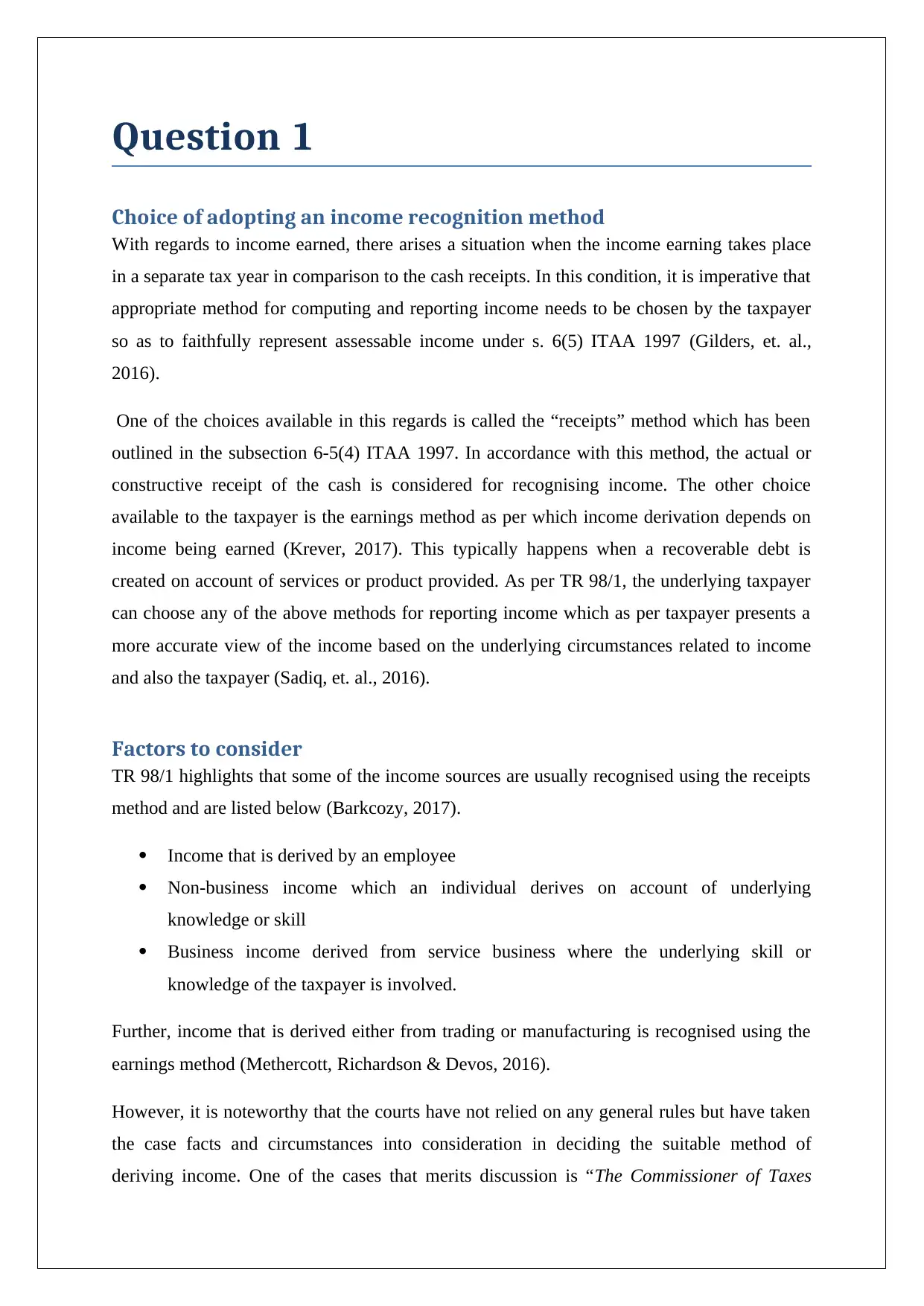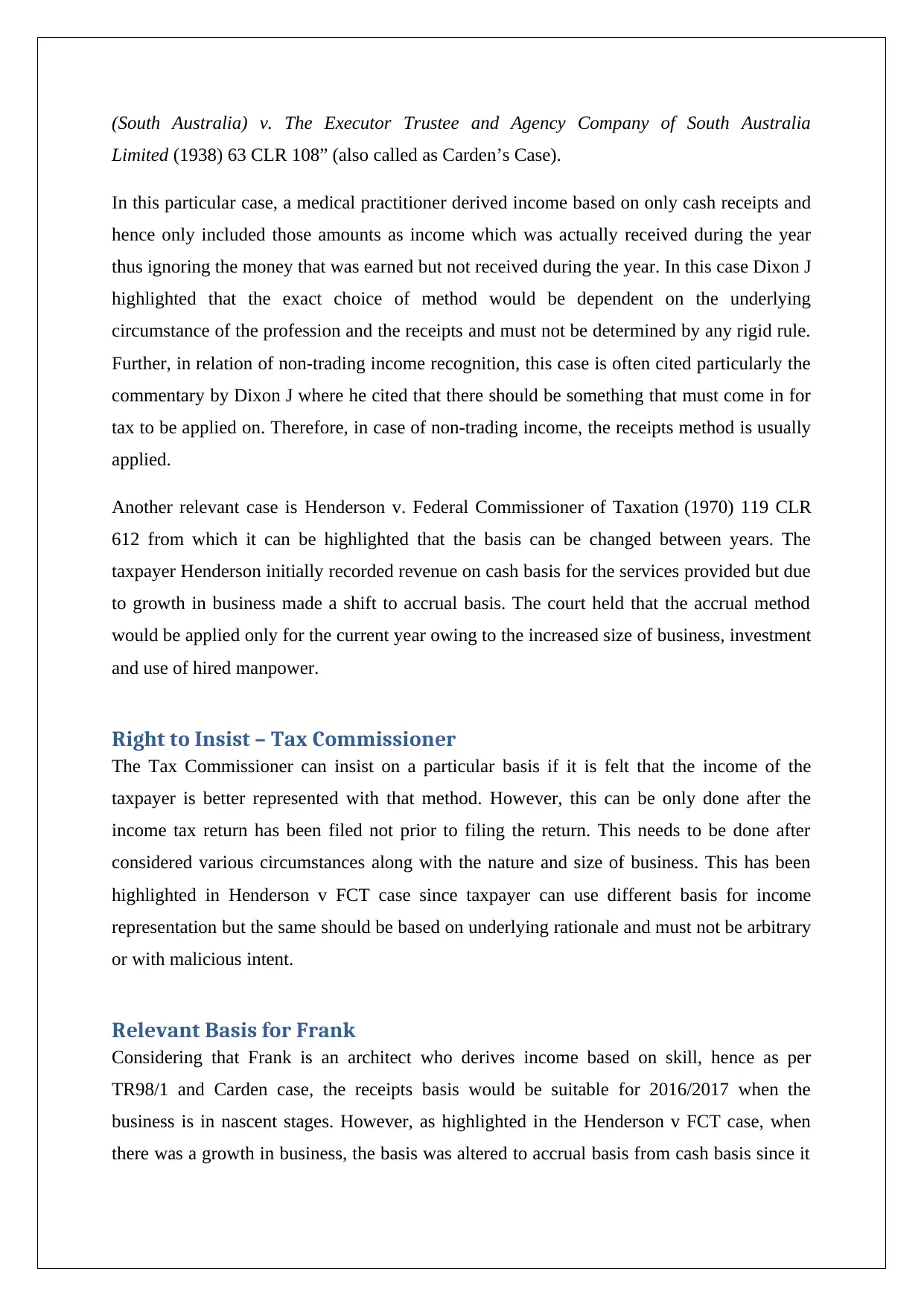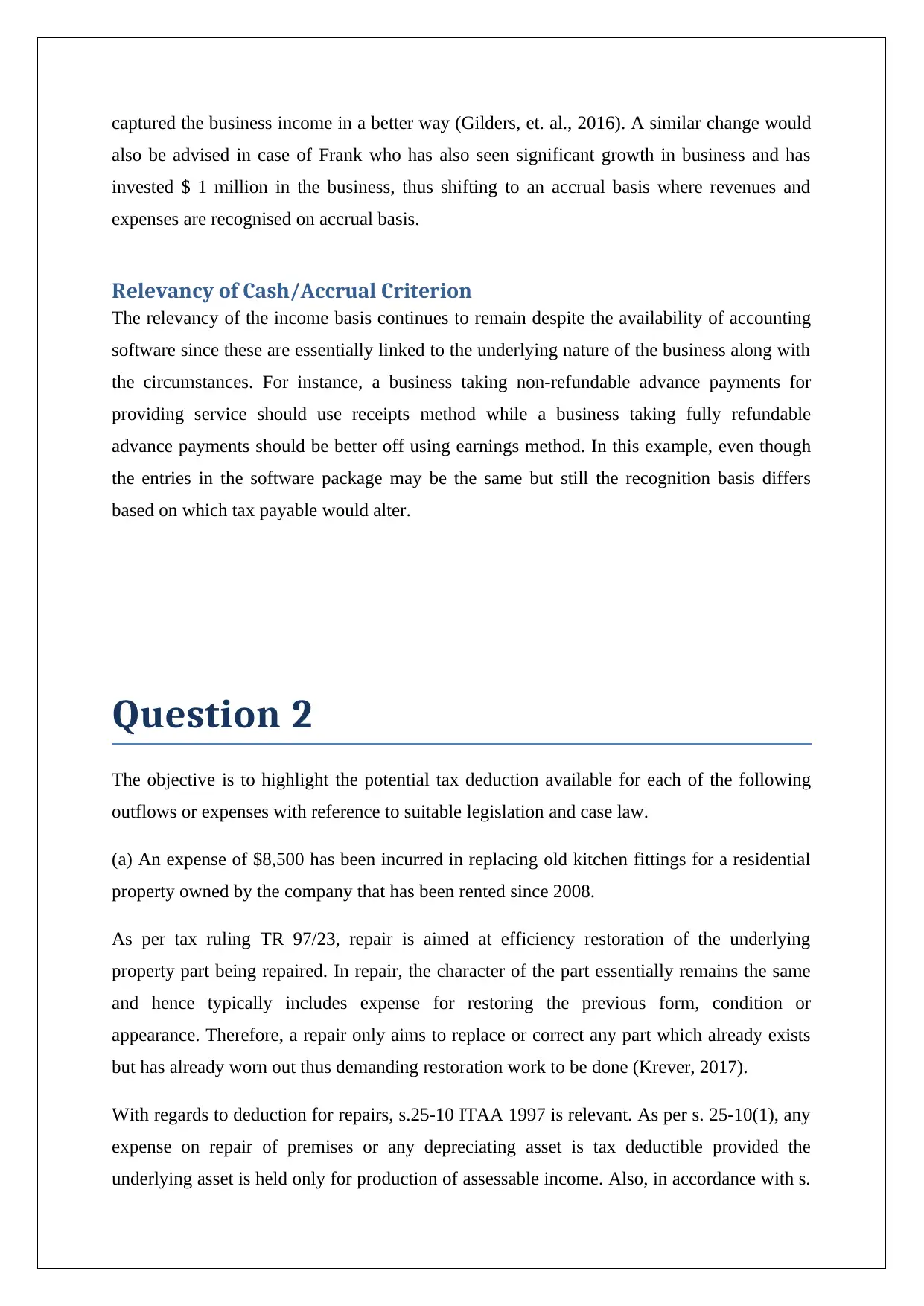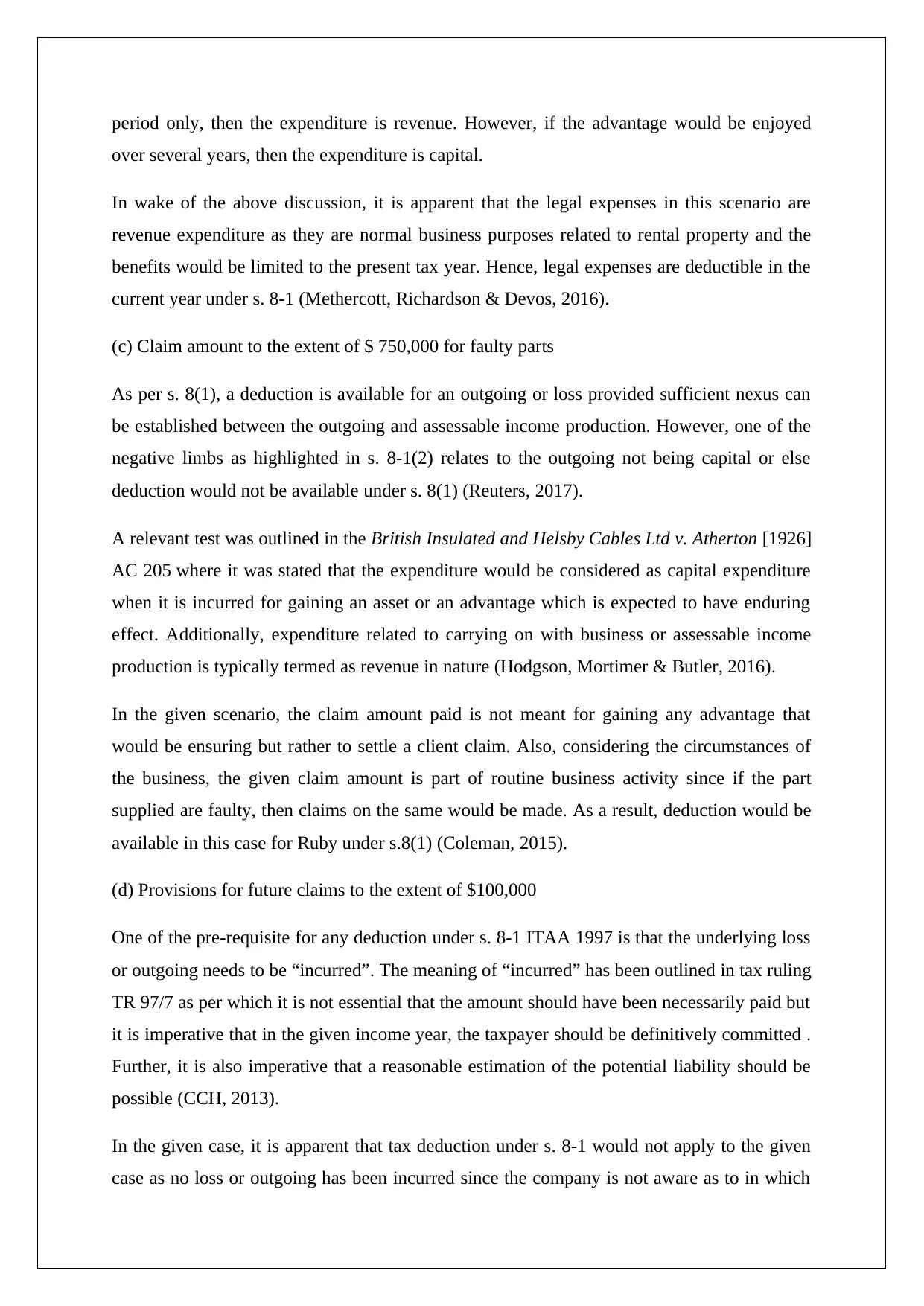BULAW 5916 Taxation Law: Income, Deductions - Federation Uni
VerifiedAdded on 2023/06/07
|9
|2755
|143
Report
AI Summary
This assignment provides a detailed analysis of income recognition methods under Australian Taxation Law, focusing on the 'receipts' and 'earnings' methods, referencing TR 98/1 and relevant case law like Carden’s Case and Henderson v FCT. It also examines the Tax Commissioner's right to insist on a particular basis and the relevance of cash/accrual criteria. Furthermore, the assignment assesses the deductibility of various expenses, including kitchen fitting replacements, legal expenses for negligence claims, provisions for future claims, and payments to consultants, with reference to sections of the ITAA 1997 and relevant case law such as Sun Newspapers Ltd v FCT and British Insulated and Helsby Cables Ltd v. Atherton. The analysis considers whether expenses are capital or revenue in nature to determine their deductibility.

TAXATION LAW
STUDENT ID:
[Pick the date]
STUDENT ID:
[Pick the date]
Paraphrase This Document
Need a fresh take? Get an instant paraphrase of this document with our AI Paraphraser

Question 1
Choice of adopting an income recognition method
With regards to income earned, there arises a situation when the income earning takes place
in a separate tax year in comparison to the cash receipts. In this condition, it is imperative that
appropriate method for computing and reporting income needs to be chosen by the taxpayer
so as to faithfully represent assessable income under s. 6(5) ITAA 1997 (Gilders, et. al.,
2016).
One of the choices available in this regards is called the “receipts” method which has been
outlined in the subsection 6-5(4) ITAA 1997. In accordance with this method, the actual or
constructive receipt of the cash is considered for recognising income. The other choice
available to the taxpayer is the earnings method as per which income derivation depends on
income being earned (Krever, 2017). This typically happens when a recoverable debt is
created on account of services or product provided. As per TR 98/1, the underlying taxpayer
can choose any of the above methods for reporting income which as per taxpayer presents a
more accurate view of the income based on the underlying circumstances related to income
and also the taxpayer (Sadiq, et. al., 2016).
Factors to consider
TR 98/1 highlights that some of the income sources are usually recognised using the receipts
method and are listed below (Barkcozy, 2017).
Income that is derived by an employee
Non-business income which an individual derives on account of underlying
knowledge or skill
Business income derived from service business where the underlying skill or
knowledge of the taxpayer is involved.
Further, income that is derived either from trading or manufacturing is recognised using the
earnings method (Methercott, Richardson & Devos, 2016).
However, it is noteworthy that the courts have not relied on any general rules but have taken
the case facts and circumstances into consideration in deciding the suitable method of
deriving income. One of the cases that merits discussion is “The Commissioner of Taxes
Choice of adopting an income recognition method
With regards to income earned, there arises a situation when the income earning takes place
in a separate tax year in comparison to the cash receipts. In this condition, it is imperative that
appropriate method for computing and reporting income needs to be chosen by the taxpayer
so as to faithfully represent assessable income under s. 6(5) ITAA 1997 (Gilders, et. al.,
2016).
One of the choices available in this regards is called the “receipts” method which has been
outlined in the subsection 6-5(4) ITAA 1997. In accordance with this method, the actual or
constructive receipt of the cash is considered for recognising income. The other choice
available to the taxpayer is the earnings method as per which income derivation depends on
income being earned (Krever, 2017). This typically happens when a recoverable debt is
created on account of services or product provided. As per TR 98/1, the underlying taxpayer
can choose any of the above methods for reporting income which as per taxpayer presents a
more accurate view of the income based on the underlying circumstances related to income
and also the taxpayer (Sadiq, et. al., 2016).
Factors to consider
TR 98/1 highlights that some of the income sources are usually recognised using the receipts
method and are listed below (Barkcozy, 2017).
Income that is derived by an employee
Non-business income which an individual derives on account of underlying
knowledge or skill
Business income derived from service business where the underlying skill or
knowledge of the taxpayer is involved.
Further, income that is derived either from trading or manufacturing is recognised using the
earnings method (Methercott, Richardson & Devos, 2016).
However, it is noteworthy that the courts have not relied on any general rules but have taken
the case facts and circumstances into consideration in deciding the suitable method of
deriving income. One of the cases that merits discussion is “The Commissioner of Taxes

(South Australia) v. The Executor Trustee and Agency Company of South Australia
Limited (1938) 63 CLR 108” (also called as Carden’s Case).
In this particular case, a medical practitioner derived income based on only cash receipts and
hence only included those amounts as income which was actually received during the year
thus ignoring the money that was earned but not received during the year. In this case Dixon J
highlighted that the exact choice of method would be dependent on the underlying
circumstance of the profession and the receipts and must not be determined by any rigid rule.
Further, in relation of non-trading income recognition, this case is often cited particularly the
commentary by Dixon J where he cited that there should be something that must come in for
tax to be applied on. Therefore, in case of non-trading income, the receipts method is usually
applied.
Another relevant case is Henderson v. Federal Commissioner of Taxation (1970) 119 CLR
612 from which it can be highlighted that the basis can be changed between years. The
taxpayer Henderson initially recorded revenue on cash basis for the services provided but due
to growth in business made a shift to accrual basis. The court held that the accrual method
would be applied only for the current year owing to the increased size of business, investment
and use of hired manpower.
Right to Insist – Tax Commissioner
The Tax Commissioner can insist on a particular basis if it is felt that the income of the
taxpayer is better represented with that method. However, this can be only done after the
income tax return has been filed not prior to filing the return. This needs to be done after
considered various circumstances along with the nature and size of business. This has been
highlighted in Henderson v FCT case since taxpayer can use different basis for income
representation but the same should be based on underlying rationale and must not be arbitrary
or with malicious intent.
Relevant Basis for Frank
Considering that Frank is an architect who derives income based on skill, hence as per
TR98/1 and Carden case, the receipts basis would be suitable for 2016/2017 when the
business is in nascent stages. However, as highlighted in the Henderson v FCT case, when
there was a growth in business, the basis was altered to accrual basis from cash basis since it
Limited (1938) 63 CLR 108” (also called as Carden’s Case).
In this particular case, a medical practitioner derived income based on only cash receipts and
hence only included those amounts as income which was actually received during the year
thus ignoring the money that was earned but not received during the year. In this case Dixon J
highlighted that the exact choice of method would be dependent on the underlying
circumstance of the profession and the receipts and must not be determined by any rigid rule.
Further, in relation of non-trading income recognition, this case is often cited particularly the
commentary by Dixon J where he cited that there should be something that must come in for
tax to be applied on. Therefore, in case of non-trading income, the receipts method is usually
applied.
Another relevant case is Henderson v. Federal Commissioner of Taxation (1970) 119 CLR
612 from which it can be highlighted that the basis can be changed between years. The
taxpayer Henderson initially recorded revenue on cash basis for the services provided but due
to growth in business made a shift to accrual basis. The court held that the accrual method
would be applied only for the current year owing to the increased size of business, investment
and use of hired manpower.
Right to Insist – Tax Commissioner
The Tax Commissioner can insist on a particular basis if it is felt that the income of the
taxpayer is better represented with that method. However, this can be only done after the
income tax return has been filed not prior to filing the return. This needs to be done after
considered various circumstances along with the nature and size of business. This has been
highlighted in Henderson v FCT case since taxpayer can use different basis for income
representation but the same should be based on underlying rationale and must not be arbitrary
or with malicious intent.
Relevant Basis for Frank
Considering that Frank is an architect who derives income based on skill, hence as per
TR98/1 and Carden case, the receipts basis would be suitable for 2016/2017 when the
business is in nascent stages. However, as highlighted in the Henderson v FCT case, when
there was a growth in business, the basis was altered to accrual basis from cash basis since it
⊘ This is a preview!⊘
Do you want full access?
Subscribe today to unlock all pages.

Trusted by 1+ million students worldwide

captured the business income in a better way (Gilders, et. al., 2016). A similar change would
also be advised in case of Frank who has also seen significant growth in business and has
invested $ 1 million in the business, thus shifting to an accrual basis where revenues and
expenses are recognised on accrual basis.
Relevancy of Cash/Accrual Criterion
The relevancy of the income basis continues to remain despite the availability of accounting
software since these are essentially linked to the underlying nature of the business along with
the circumstances. For instance, a business taking non-refundable advance payments for
providing service should use receipts method while a business taking fully refundable
advance payments should be better off using earnings method. In this example, even though
the entries in the software package may be the same but still the recognition basis differs
based on which tax payable would alter.
Question 2
The objective is to highlight the potential tax deduction available for each of the following
outflows or expenses with reference to suitable legislation and case law.
(a) An expense of $8,500 has been incurred in replacing old kitchen fittings for a residential
property owned by the company that has been rented since 2008.
As per tax ruling TR 97/23, repair is aimed at efficiency restoration of the underlying
property part being repaired. In repair, the character of the part essentially remains the same
and hence typically includes expense for restoring the previous form, condition or
appearance. Therefore, a repair only aims to replace or correct any part which already exists
but has already worn out thus demanding restoration work to be done (Krever, 2017).
With regards to deduction for repairs, s.25-10 ITAA 1997 is relevant. As per s. 25-10(1), any
expense on repair of premises or any depreciating asset is tax deductible provided the
underlying asset is held only for production of assessable income. Also, in accordance with s.
also be advised in case of Frank who has also seen significant growth in business and has
invested $ 1 million in the business, thus shifting to an accrual basis where revenues and
expenses are recognised on accrual basis.
Relevancy of Cash/Accrual Criterion
The relevancy of the income basis continues to remain despite the availability of accounting
software since these are essentially linked to the underlying nature of the business along with
the circumstances. For instance, a business taking non-refundable advance payments for
providing service should use receipts method while a business taking fully refundable
advance payments should be better off using earnings method. In this example, even though
the entries in the software package may be the same but still the recognition basis differs
based on which tax payable would alter.
Question 2
The objective is to highlight the potential tax deduction available for each of the following
outflows or expenses with reference to suitable legislation and case law.
(a) An expense of $8,500 has been incurred in replacing old kitchen fittings for a residential
property owned by the company that has been rented since 2008.
As per tax ruling TR 97/23, repair is aimed at efficiency restoration of the underlying
property part being repaired. In repair, the character of the part essentially remains the same
and hence typically includes expense for restoring the previous form, condition or
appearance. Therefore, a repair only aims to replace or correct any part which already exists
but has already worn out thus demanding restoration work to be done (Krever, 2017).
With regards to deduction for repairs, s.25-10 ITAA 1997 is relevant. As per s. 25-10(1), any
expense on repair of premises or any depreciating asset is tax deductible provided the
underlying asset is held only for production of assessable income. Also, in accordance with s.
Paraphrase This Document
Need a fresh take? Get an instant paraphrase of this document with our AI Paraphraser

25-10(3), repair deduction under this section is available only for operating expenditure and
not for capital expenditure (Woellner, 2014). Further, deduction for repairs is also
permissible under s.8(1) provided the nexus with income production can be sufficiently
established and also the outgoings is not capital expenditure as per s. 8-1(2) ITAA 1997.
However, repair expenses are deductible only under one of the above two sections and cannot
be deducted twice (Reuters, 2017).
As per IT 242, there are certain assets which are permanent fixtures such as kitchen
cupboards, sinks, kitchen plumbings, built in stove, which are essential building fixtures and
thereby no depreciation can be claimed on same. Further, TR 97/23 highlights that expenses
incurred for replacing the in-built furniture, stove, refrigerator are capital expenditures and
therefore non-deductible under s. 25-10 and also s.8-1. The given repairs to kitchen fittings
and cupboards would be capital in nature based on the above discussion. As a result, the
current expenses would not be deductible immediately and therefore the complete amount
may be deducted over the five year period under s. 40-880 (Woellner, 2014).
(b) Legal expenses of $ 7,000 for defending against negligence claim
As per s. 8(1), a deduction is available for an outgoing or loss provided sufficient nexus can
be established between the outgoing and assessable income production. However, one of the
negative limbs as highlighted in s. 8-1(2) relates to the outgoing not being capital or else
deduction would not be available under s. 8(1) (Hodgson, Mortimer & Butler, 2016).
In light of the above, the key objective is to be determine whether the legal expenses in this
case is revenue expenditure or capital expenditure. Dixon J in Sun Newspapers Ltd and
Associated Newspapers Ltd v. Federal Commissioner of Taxation (1938) 61 CLR 33
highlighted the following three aspects so as to segregate capital expenditure from revenue
expenditure (Woellner, 2014).
The essential character of the advantage that would result from the outgoing
The method of usage of the underlying advantage by the taxpayer
The underlying means for obtaining the advantage
Amongst the above, the first and the third aspects are not that critical as highlighted in Sun
Newspapers Ltd and Associated Newspapers Ltd v. Federal Commissioner of
Taxation (1938) 61 CLR 33 case (CCH, 2013). Thus, the pivotal element is how the
underlying advantage is used. In this regards, if the advantage extends to the current tax
not for capital expenditure (Woellner, 2014). Further, deduction for repairs is also
permissible under s.8(1) provided the nexus with income production can be sufficiently
established and also the outgoings is not capital expenditure as per s. 8-1(2) ITAA 1997.
However, repair expenses are deductible only under one of the above two sections and cannot
be deducted twice (Reuters, 2017).
As per IT 242, there are certain assets which are permanent fixtures such as kitchen
cupboards, sinks, kitchen plumbings, built in stove, which are essential building fixtures and
thereby no depreciation can be claimed on same. Further, TR 97/23 highlights that expenses
incurred for replacing the in-built furniture, stove, refrigerator are capital expenditures and
therefore non-deductible under s. 25-10 and also s.8-1. The given repairs to kitchen fittings
and cupboards would be capital in nature based on the above discussion. As a result, the
current expenses would not be deductible immediately and therefore the complete amount
may be deducted over the five year period under s. 40-880 (Woellner, 2014).
(b) Legal expenses of $ 7,000 for defending against negligence claim
As per s. 8(1), a deduction is available for an outgoing or loss provided sufficient nexus can
be established between the outgoing and assessable income production. However, one of the
negative limbs as highlighted in s. 8-1(2) relates to the outgoing not being capital or else
deduction would not be available under s. 8(1) (Hodgson, Mortimer & Butler, 2016).
In light of the above, the key objective is to be determine whether the legal expenses in this
case is revenue expenditure or capital expenditure. Dixon J in Sun Newspapers Ltd and
Associated Newspapers Ltd v. Federal Commissioner of Taxation (1938) 61 CLR 33
highlighted the following three aspects so as to segregate capital expenditure from revenue
expenditure (Woellner, 2014).
The essential character of the advantage that would result from the outgoing
The method of usage of the underlying advantage by the taxpayer
The underlying means for obtaining the advantage
Amongst the above, the first and the third aspects are not that critical as highlighted in Sun
Newspapers Ltd and Associated Newspapers Ltd v. Federal Commissioner of
Taxation (1938) 61 CLR 33 case (CCH, 2013). Thus, the pivotal element is how the
underlying advantage is used. In this regards, if the advantage extends to the current tax

period only, then the expenditure is revenue. However, if the advantage would be enjoyed
over several years, then the expenditure is capital.
In wake of the above discussion, it is apparent that the legal expenses in this scenario are
revenue expenditure as they are normal business purposes related to rental property and the
benefits would be limited to the present tax year. Hence, legal expenses are deductible in the
current year under s. 8-1 (Methercott, Richardson & Devos, 2016).
(c) Claim amount to the extent of $ 750,000 for faulty parts
As per s. 8(1), a deduction is available for an outgoing or loss provided sufficient nexus can
be established between the outgoing and assessable income production. However, one of the
negative limbs as highlighted in s. 8-1(2) relates to the outgoing not being capital or else
deduction would not be available under s. 8(1) (Reuters, 2017).
A relevant test was outlined in the British Insulated and Helsby Cables Ltd v. Atherton [1926]
AC 205 where it was stated that the expenditure would be considered as capital expenditure
when it is incurred for gaining an asset or an advantage which is expected to have enduring
effect. Additionally, expenditure related to carrying on with business or assessable income
production is typically termed as revenue in nature (Hodgson, Mortimer & Butler, 2016).
In the given scenario, the claim amount paid is not meant for gaining any advantage that
would be ensuring but rather to settle a client claim. Also, considering the circumstances of
the business, the given claim amount is part of routine business activity since if the part
supplied are faulty, then claims on the same would be made. As a result, deduction would be
available in this case for Ruby under s.8(1) (Coleman, 2015).
(d) Provisions for future claims to the extent of $100,000
One of the pre-requisite for any deduction under s. 8-1 ITAA 1997 is that the underlying loss
or outgoing needs to be “incurred”. The meaning of “incurred” has been outlined in tax ruling
TR 97/7 as per which it is not essential that the amount should have been necessarily paid but
it is imperative that in the given income year, the taxpayer should be definitively committed .
Further, it is also imperative that a reasonable estimation of the potential liability should be
possible (CCH, 2013).
In the given case, it is apparent that tax deduction under s. 8-1 would not apply to the given
case as no loss or outgoing has been incurred since the company is not aware as to in which
over several years, then the expenditure is capital.
In wake of the above discussion, it is apparent that the legal expenses in this scenario are
revenue expenditure as they are normal business purposes related to rental property and the
benefits would be limited to the present tax year. Hence, legal expenses are deductible in the
current year under s. 8-1 (Methercott, Richardson & Devos, 2016).
(c) Claim amount to the extent of $ 750,000 for faulty parts
As per s. 8(1), a deduction is available for an outgoing or loss provided sufficient nexus can
be established between the outgoing and assessable income production. However, one of the
negative limbs as highlighted in s. 8-1(2) relates to the outgoing not being capital or else
deduction would not be available under s. 8(1) (Reuters, 2017).
A relevant test was outlined in the British Insulated and Helsby Cables Ltd v. Atherton [1926]
AC 205 where it was stated that the expenditure would be considered as capital expenditure
when it is incurred for gaining an asset or an advantage which is expected to have enduring
effect. Additionally, expenditure related to carrying on with business or assessable income
production is typically termed as revenue in nature (Hodgson, Mortimer & Butler, 2016).
In the given scenario, the claim amount paid is not meant for gaining any advantage that
would be ensuring but rather to settle a client claim. Also, considering the circumstances of
the business, the given claim amount is part of routine business activity since if the part
supplied are faulty, then claims on the same would be made. As a result, deduction would be
available in this case for Ruby under s.8(1) (Coleman, 2015).
(d) Provisions for future claims to the extent of $100,000
One of the pre-requisite for any deduction under s. 8-1 ITAA 1997 is that the underlying loss
or outgoing needs to be “incurred”. The meaning of “incurred” has been outlined in tax ruling
TR 97/7 as per which it is not essential that the amount should have been necessarily paid but
it is imperative that in the given income year, the taxpayer should be definitively committed .
Further, it is also imperative that a reasonable estimation of the potential liability should be
possible (CCH, 2013).
In the given case, it is apparent that tax deduction under s. 8-1 would not apply to the given
case as no loss or outgoing has been incurred since the company is not aware as to in which
⊘ This is a preview!⊘
Do you want full access?
Subscribe today to unlock all pages.

Trusted by 1+ million students worldwide

year, the matter would be settled and cannot make a reasonable estimation of the liability
amount (Woellner, 2014). Thus, till the time the court verdict comes, the outgoing would not
have been deemed to be “incurred” and therefore no deduction possible for provisions.
(e) Amount paid to consultants to the tune of $ 220,000
As per s. 8(1), a deduction is available for an outgoing or loss provided sufficient nexus can
be established between the outgoing and assessable income production. However, one of the
negative limbs as highlighted in s. 8-1(2) relates to the outgoing not being capital or else
deduction would not be available under s. 8(1) (Deutsch, et.al., 2016). In the given case, the
nature of the expense would be capital (in accordance with Sun Newspapers Ltd and
Associated Newspapers Ltd v. Federal Commissioner of Taxation (1938) 61 CLR 33) since
the market research is related to start-up of business whose expected benefits would be
realised by the company over years (Sadiq, et. al., 2016).
In accordance with s. 40-880(2A) ITAA 1997, any capital expenditure which is related to
future business can be deducted equally over a period of five years irrespective of whether
the business is eventually started or not (Coleman, 2015). Also, this includes expenditure
related to seeking advice for the operations or business structure. Thus, in line with s. 40-
880(2A), 100% deduction of the market research costs can be availed by Ruby over a period
of 5 years with annual deduction being (220000/5) or $ 44,000.
amount (Woellner, 2014). Thus, till the time the court verdict comes, the outgoing would not
have been deemed to be “incurred” and therefore no deduction possible for provisions.
(e) Amount paid to consultants to the tune of $ 220,000
As per s. 8(1), a deduction is available for an outgoing or loss provided sufficient nexus can
be established between the outgoing and assessable income production. However, one of the
negative limbs as highlighted in s. 8-1(2) relates to the outgoing not being capital or else
deduction would not be available under s. 8(1) (Deutsch, et.al., 2016). In the given case, the
nature of the expense would be capital (in accordance with Sun Newspapers Ltd and
Associated Newspapers Ltd v. Federal Commissioner of Taxation (1938) 61 CLR 33) since
the market research is related to start-up of business whose expected benefits would be
realised by the company over years (Sadiq, et. al., 2016).
In accordance with s. 40-880(2A) ITAA 1997, any capital expenditure which is related to
future business can be deducted equally over a period of five years irrespective of whether
the business is eventually started or not (Coleman, 2015). Also, this includes expenditure
related to seeking advice for the operations or business structure. Thus, in line with s. 40-
880(2A), 100% deduction of the market research costs can be availed by Ruby over a period
of 5 years with annual deduction being (220000/5) or $ 44,000.
Paraphrase This Document
Need a fresh take? Get an instant paraphrase of this document with our AI Paraphraser

References
Barkoczy, S. (2017) Foundation of Taxation Law 2017. 9th ed. Sydney: Oxford University
Press.
CCH (2013), Australian Master Tax Guide 2013, 51st ed., Sydney: Wolters Kluwer.
Coleman, C. (2015) Australian Tax Analysis (4th ed.). Sydney: Thomson Reuters
(Professional) Australia.
Deutsch, R., Freizer, M., Fullerton, I., Hanley, P., & Snape, T. (2016) Australian tax
handbook. 8th ed. Pymont: Thomson Reuters.
Gilders, F., Taylor, J., Walpole, M., Burton, M. & Ciro, T. (2016) Understanding taxation
law 2016. 9th ed. Sydney: LexisNexis/Butterworths.
Hodgson, H., Mortimer, C. & Butler, J. (2016) Tax Questions and Answers 2016 (6th ed.).
Sydney: Thomson Reuters.
Krever, R. (2017) Australian Taxation Law Cases 2017 2nd ed. Brisbane: THOMSON
LAWBOOK Company.
Nethercott, L., Richardson, G., & Devos, K. (2016) Australian Taxation Study Manual 2016.
(8th ed.). Sydney: Oxford University Press.
Reuters, T. (2017) Australian Tax Legislation 2017 (4th ed.). Sydney. THOMSON
REUTERS.
Sadiq, K, Coleman, C, Hanegbi, R, Jogarajan, S, Krever, R, Obst, W, & Ting, A
(2016) , Principles of Taxation Law 2016, 8th ed., Pymont: Thomson Reuters.
Woellner, R (2014), Australian taxation law 2014 7th ed. North Ryde: CCH Australia.
Barkoczy, S. (2017) Foundation of Taxation Law 2017. 9th ed. Sydney: Oxford University
Press.
CCH (2013), Australian Master Tax Guide 2013, 51st ed., Sydney: Wolters Kluwer.
Coleman, C. (2015) Australian Tax Analysis (4th ed.). Sydney: Thomson Reuters
(Professional) Australia.
Deutsch, R., Freizer, M., Fullerton, I., Hanley, P., & Snape, T. (2016) Australian tax
handbook. 8th ed. Pymont: Thomson Reuters.
Gilders, F., Taylor, J., Walpole, M., Burton, M. & Ciro, T. (2016) Understanding taxation
law 2016. 9th ed. Sydney: LexisNexis/Butterworths.
Hodgson, H., Mortimer, C. & Butler, J. (2016) Tax Questions and Answers 2016 (6th ed.).
Sydney: Thomson Reuters.
Krever, R. (2017) Australian Taxation Law Cases 2017 2nd ed. Brisbane: THOMSON
LAWBOOK Company.
Nethercott, L., Richardson, G., & Devos, K. (2016) Australian Taxation Study Manual 2016.
(8th ed.). Sydney: Oxford University Press.
Reuters, T. (2017) Australian Tax Legislation 2017 (4th ed.). Sydney. THOMSON
REUTERS.
Sadiq, K, Coleman, C, Hanegbi, R, Jogarajan, S, Krever, R, Obst, W, & Ting, A
(2016) , Principles of Taxation Law 2016, 8th ed., Pymont: Thomson Reuters.
Woellner, R (2014), Australian taxation law 2014 7th ed. North Ryde: CCH Australia.

⊘ This is a preview!⊘
Do you want full access?
Subscribe today to unlock all pages.

Trusted by 1+ million students worldwide
1 out of 9
Related Documents
Your All-in-One AI-Powered Toolkit for Academic Success.
+13062052269
info@desklib.com
Available 24*7 on WhatsApp / Email
![[object Object]](/_next/static/media/star-bottom.7253800d.svg)
Unlock your academic potential
Copyright © 2020–2025 A2Z Services. All Rights Reserved. Developed and managed by ZUCOL.





